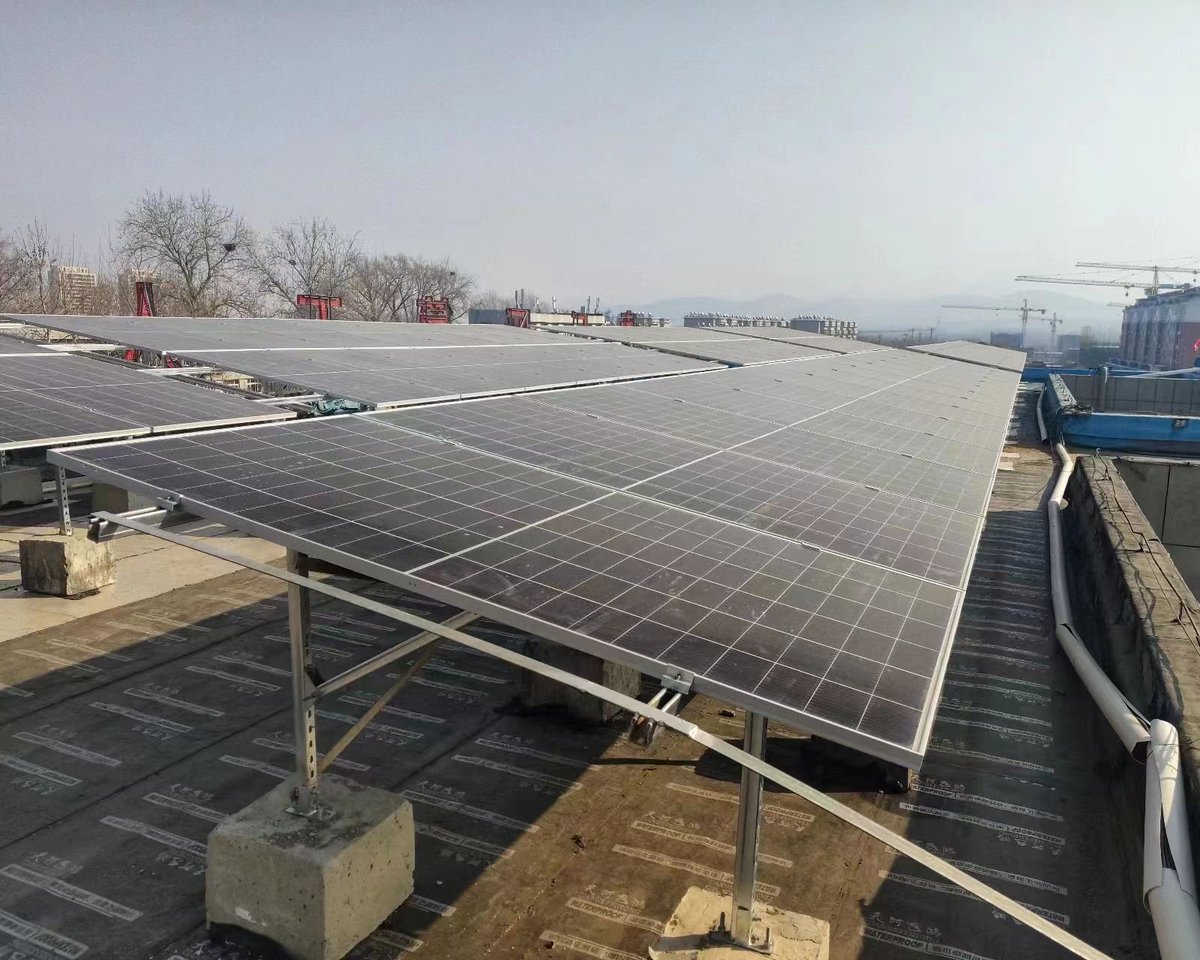A boots-on-the-rooftop view of China’s solar photovoltaic boom
Can private companies make a profit pursuing clean energy? In one eastern China province, at least so far, the answer is yes.

It’s a smoggy, blustery February day on this Shandong rooftop in eastern China. In the lulls between gusts of wind, the buzzy squeal of power drills is clearly audible, their high-pitched whine echoing around the empty courtyard below. On a roof just below where I’m standing, a team of six men in yellow safety vests and hardhats are busily screwing concrete blocks into metal baseplates, upon which they will soon mount neat rows of skyward-facing steel frames. One of them catches me peering over the edge of my rooftop to snap a picture and shoots me an energetic thumbs up before returning to his work. Today may be a Sunday, and a holiday (Lantern Festival, the 15th day of Chinese New Year celebrations), but that means little for this construction team. Holiday or not, today Jinan City Zhangqiu District No. 2 Middle School is getting solar panels installed on its cafeteria roof.
“Actually, this project is a little bit behind schedule,” Dong Yongshun tells me in his thick Shandong brogue. A cheerful local guy with a round, tanned face that has clearly spent many an hour atop dusty rooftops, Dong is a project manager at State Cloud Smart Energy Technology, a Jinan company that has won the consolidated tender to build rooftop solar panels across all the public buildings in Zhangqiu District (population 1 million). “Our construction was slowed by the pandemic last year, but we are trying to catch up.” After a moment, he adds, “Also, building on schools is generally slower. We can’t work during the day because it would disturb the students. Once we finish here, we’ll start on the government buildings across the street.”
State Cloud, founded three years ago, has 80 full-time employees, though it employs many more part-time construction workers. Private investors are the largest stakeholders, but it does have state-backed investors. It is merely one of thousands of companies that have recently sprung up to pursue a profit in the clean-energy sector. More importantly, it is an example of how government initiatives that seem like they would be more of a natural match for state-owned enterprises (SOEs) wound up attracting an unexpected legion of scrappy private-sector businesses instead.
When Dong’s team finishes here, the school’s rooftops are expected to yield 223 kilowatts of solar capacity. On the roof of the county hospital next door, State Cloud has already installed another 145 kilowatts, which are awaiting a final inspection from the local grid company before they begin generating power. To compensate the building owner for the use of their rooftop, State Cloud will sell the power to the owner at a 10% discount versus its normal power rate. Any time the rooftop owner doesn’t need the power generated (for example, during public holidays), the local grid company will buy the power instead.
As the project manager, Dong visits every site personally, negotiates contracts with the rooftop owners and local grid companies, and ensures the work progresses according to a strict schedule. According to the tender they won, they need to install solar panels atop 90 schools and 30 hospitals in Zhangqiu District alone by the end of 2023. At the same time, they’ve already started survey work on three other counties where they’ve won similar tenders, with contracts signed for a further dozen. Apparently, business is good.

Watchers of the Chinese energy sector will already know that solar had a huge year in 2022, reaching 392 GW of installed capacity by adding a stunning 87 GW in one year, two-thirds of which were on rooftops. A big part of that success can be attributed to the “Whole-County Rooftop Solar” (整县屋顶光伏 zhěng xiàn wūdǐng guāngfú) initiative launched in 2021. Under this, solar developers bid on project development rights for an entire county-level administrative unit. Winning developers then strive to meet rooftop solar coverage quotas for different types of buildings within the county, including public buildings (at least 50%), commercial and industrial buildings (at least 30%), and residential buildings (at least 20%). Using these ratios, State Cloud estimates Zhangqiu’s rooftops will yield around 150 megawatts once the entire district is developed.
Despite solar’s use of toxic chemicals and metals — and possible future recycling challenges — in the short term its generation has replaced a significant amount of coal consumption, so it definitely should be seen as a net gain for the environment. China hopes to cap coal consumption by 2025 and cap whole-economy carbon emissions by 2030. Installing solar or wind in provinces where you know it’s displacing coal generation is a direct contribution to meeting those goals.
State Cloud has chosen to start with the public buildings, which see decent returns for the developer, before moving on to the residential rooftops, which are less profitable (Dong said they’ll be lucky to break even on those, since development costs are much higher). As for the commercial and industrial buildings…they’re delaying those for as long as possible, hoping for better market conditions. “It’s too hard right now,” Dong says. “We have many competitors, and the factories aren’t required to choose us as the rooftop developer, because they are private enterprises. If we want to build on a factory rooftop, I might need to offer them a discount of 30% versus their current power rate to win. Meanwhile, the panels are still so expensive. It’s not worth it.”
Despite the robust growth, that’s not the only challenge small solar developers currently face in Shandong. Seemingly a victim of its own success, Shandong is now showing clear signs of power oversupply during the peak solar generation hours from 11 a.m. to 2 p.m., especially when factory workers go on lunch breaks, causing industrial power demand to dip. Increasingly, Shandong’s grid company will only offer solar developers the real-time spot power rate for their generation, which cuts into margins for any power that is sold to the grid instead of the rooftop owner. State Cloud, as a smaller private developer (although it counts state-backed asset management firms among its shareholders), targets a rate of return on capital of just 6 to 6.5% in Zhangqiu, lower than the returns usually targeted by international private equity (12%) or even Chinese SOEs (8%).
“Actually, the large SOEs can’t really develop these projects,” Dong tells me, somewhat matter-of-factly. “Even if they win the project in the tender phase, they often have to outsource it to companies like us in the end, because they’re not local enough to do the work. They don’t have the relationships with the local grid company, or the local government.” In other words, the thinner the margins, ironically, the more opportunities that provides for private-sector players.
Dong also adds that the projects in this area have higher maintenance costs, as dust from nearby construction projects necessitates frequent panel-cleaning to maintain good performance. They have already hired a local company for this.

Problems notwithstanding, Shandong is quite advanced in its rooftop solar rollout, which is why it boasts the largest installed solar capacity of any Chinese province. However, the striking additions last year in other eastern provinces like Jiangsu, Anhui, and Henan indicate rooftop solar is booming there, too. None of these provinces are noted for having particularly excellent solar irradiance — at least not compared to areas like Inner Mongolia, Gansu, or Qinghai. But crucially, these are the regions that need more power, especially renewables. While Qinghai may have excellent solar resources, its power demand and tariffs are very low, so these days, developers see a harder path to profitability building there. Shandong, by contrast, is a net power importer heavily reliant on coal, with strong demand and high power tariffs. With the right mix of policy support and pricing incentives, provincial governments like Shandong’s have succeeded in making rooftop solar projects profitable, even in regions with mediocre solar resources, bringing developers and capital flocking.
And of course, where there’s money to be made, the competition is cut-throat. Dong notes frankly that there’s nothing particularly unique about his company; there are hundreds, perhaps thousands, of companies just like his, all scrambling for a piece of the rooftop solar pie.
So yes, it’s a hard-knock life for a rooftop solar developer, and they surely won’t all survive, but such fierce competition only can mean good things for power customers, as they are wooed by builders willing to offer ever-larger discounts while accepting ever-thinner margins to win their business. In this program, China’s successful effort to stimulate such impressive capacity growth in regions with poor irradiance and limited land, generating power at a rate attractive to the rooftop owner, while still earning a rate of return acceptable to the developer, seems damn near miraculous. Surely, there is much in this model worthy of adoption or adaptation elsewhere, particularly for parts of the world with underwhelming natural renewable resources still struggling to add green power into their capacity mix. As Frank Sinatra famously crooned: if you can make it on these dusty, smoggy Shandong rooftops, you can make it anywhere.
Something like that, anyway.






